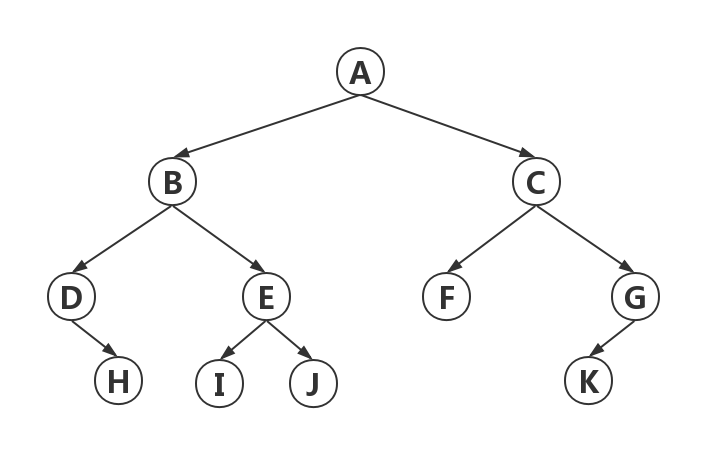版权声明:转载请写明出处,谢谢! https://blog.csdn.net/wilson1068/article/details/88385988
树的括号表示
树的括号表示规则
-
若树 T 为空树,则其括号表示为空
-
若树 T 只包含一个结点,则其括号表示即为该结点本身
-
若树 T 由根结点 A 和它的 m 棵子树 构成,则其括号表示为:A ( 的括号表示, 的括号表示, , 的括号表示)
其中,子树的括号表示同样应该遵循以上规则。
以下二叉树的括号表示结果为:
A(B(D(,H), E(I, J)), C(F, G(K)))

括号表示法创建二叉树
注意:不保证输入参数的有效性,请自行确保。
每个节点的结构体为:
typedef struct _stBinaryTreeNode {
void * data; // 保存数据,可以存储数据指针或者地址大小范围内的数值
struct _stBinaryTreeNode * lchild; // 左子节点的地址
struct _stBinaryTreeNode * rchild; // 右子节点的地址
} stBinaryTreeNode;
括号表示法以“最小”的括号包含一个最小的树,所以建立树的时候需要采用类似深度优先搜索的方式,建立最底层的树,然后往上完善一棵棵树。
通过括号表达式,建立二叉树的方法为:
stBinaryTreeNode * createBinaryTree(char * strBrackTree) {
stBinaryTreeNode * root = NULL;
if (strBrackTree == NULL) {
return root;
}
int len = strlen(strBrackTree);
if (len == 0) {
return root;
}
// 栈,保存 node 节点地址
stBinaryTreeNode ** node_stack = (stBinaryTreeNode **) malloc(sizeof(stBinaryTreeNode *) * len);
int top = -1;
stBinaryTreeNode * node;
int child_index = 0;
for (int i = 0; i < len; ++ i) {
char ch = strBrackTree[i];
switch (ch) {
case '(':
node_stack[++top] = node; // 保存当前 parent 节点
child_index = 0; // 初始化子节点 index
break;
case ',':
child_index ++; // 更新子节点 index
break;
case ')':
node_stack[--top]; // 移除已匹配的 parent 节点
break;
case ' ':
break;
default:
node = (stBinaryTreeNode *) malloc(sizeof(stBinaryTreeNode));
node->lchild = NULL;
node->rchild = NULL;
node->data = (void *) ch;
if (root == NULL) {
root = node;
} else {
if (child_index == 0) {
node_stack[top]->lchild = node; // 更新当前 parent 的左子节点
} else {
node_stack[top]->rchild = node; // 更新当前 parent 的右子节点
}
}
break;
}
}
free(node_stack);
return root;
}
递归式打印出该树的括号表达式的方法:
int printBinaryTreeToBrackString(stBinaryTreeNode * node, char * out_msg) {
int out_len = 0;
if (out_msg == NULL || node == NULL) {
return out_len;
}
out_msg[out_len++] = (int) node->data;
if (node->lchild != NULL || node->rchild != NULL) {
out_msg[out_len++] = '(';
out_len += printBinaryTreeToBrackString(node->lchild, out_msg + out_len);
if (node->rchild != NULL) {
out_msg[out_len++] = ',';
}
out_len += printBinaryTreeToBrackString(node->rchild, out_msg + out_len);
out_msg[out_len++] = ')';
}
out_msg[out_len] = 0;
return out_len;
}
测试数据运行结果如下:
INPUT TREE : A(B(D(,H), E(I, J)), C(F, G(K)))
OUTPUT TREE : A(B(D(,H),E(I,J)),C(F,G(K))) ### len = 28
完整代码如下:
#include <stdio.h>
#include <stdlib.h>
#include <string.h>
#define BRACK_TO_BINARY_TREE "A(B(D(, H), E(I, J)), C(F, G(K)))"
typedef struct _stBinaryTreeNode {
void * data; // 保存数据,可以存储数据指针或者地址大小范围内的数值
struct _stBinaryTreeNode * lchild; // 左子节点的地址
struct _stBinaryTreeNode * rchild; // 右子节点的地址
} stBinaryTreeNode;
stBinaryTreeNode * createBinaryTree(char * strBrackTree) {
stBinaryTreeNode * root = NULL;
if (strBrackTree == NULL) {
return root;
}
int len = strlen(strBrackTree);
if (len == 0) {
return root;
}
// 栈,保存 node 节点地址
stBinaryTreeNode ** node_stack = (stBinaryTreeNode **) malloc(sizeof(stBinaryTreeNode *) * len);
int top = -1;
stBinaryTreeNode * node;
int child_index = 0;
for (int i = 0; i < len; ++ i) {
char ch = strBrackTree[i];
switch (ch) {
case '(':
node_stack[++top] = node; // 保存当前 parent 节点
child_index = 0; // 初始化子节点 index
break;
case ',':
child_index ++; // 更新子节点 index
break;
case ')':
node_stack[--top]; // 移除已匹配的 parent 节点
break;
case ' ':
break;
default:
node = (stBinaryTreeNode *) malloc(sizeof(stBinaryTreeNode));
node->lchild = NULL;
node->rchild = NULL;
node->data = (void *) ch;
if (root == NULL) {
root = node;
} else {
if (child_index == 0) {
node_stack[top]->lchild = node; // 更新当前 parent 的左子节点
} else {
node_stack[top]->rchild = node; // 更新当前 parent 的右子节点
}
}
break;
}
}
free(node_stack);
return root;
}
int printBinaryTreeToBrackString(stBinaryTreeNode * node, char * out_msg) {
int out_len = 0;
if (out_msg == NULL || node == NULL) {
return out_len;
}
out_msg[out_len++] = (int) node->data;
if (node->lchild != NULL || node->rchild != NULL) {
out_msg[out_len++] = '(';
out_len += printBinaryTreeToBrackString(node->lchild, out_msg + out_len);
if (node->rchild != NULL) {
out_msg[out_len++] = ',';
}
out_len += printBinaryTreeToBrackString(node->rchild, out_msg + out_len);
out_msg[out_len++] = ')';
}
out_msg[out_len] = 0;
return out_len;
}
stBinaryTreeNode * destoryBinaryTree(stBinaryTreeNode * node) {
if (node != NULL) {
destoryBinaryTree(node->lchild);
destoryBinaryTree(node->rchild);
free(node);
node = NULL;
}
return node;
}
int main() {
char msg[128];
stBinaryTreeNode * tree = createBinaryTree(BRACK_TO_BINARY_TREE);
printf("INPUT TREE : %s\n", BRACK_TO_BINARY_TREE);
int len = printBinaryTreeToBrackString(tree, msg);
printf("OUTPUT TREE : %s ### len = %d\n", msg, len);
tree = destoryBinaryTree(tree);
return 0;
}